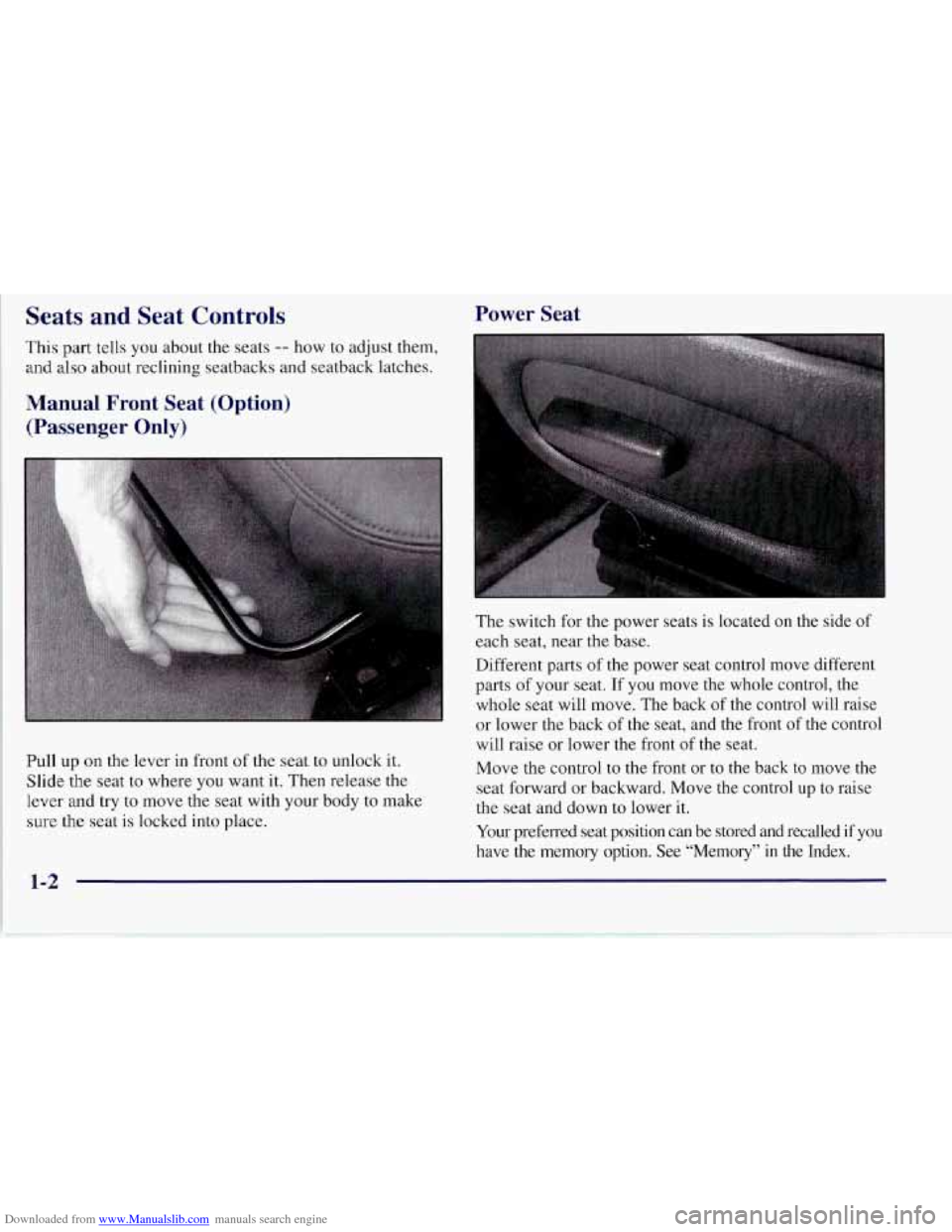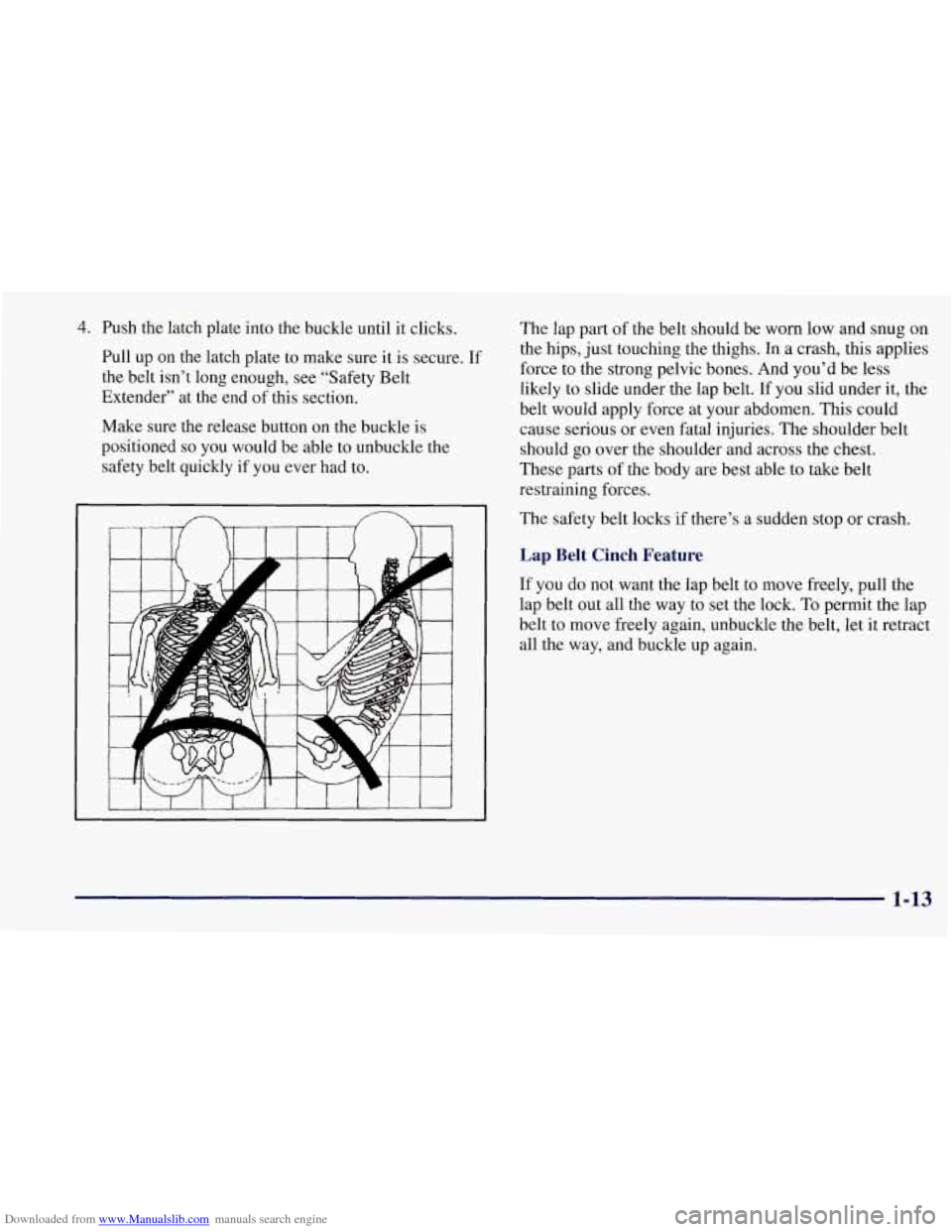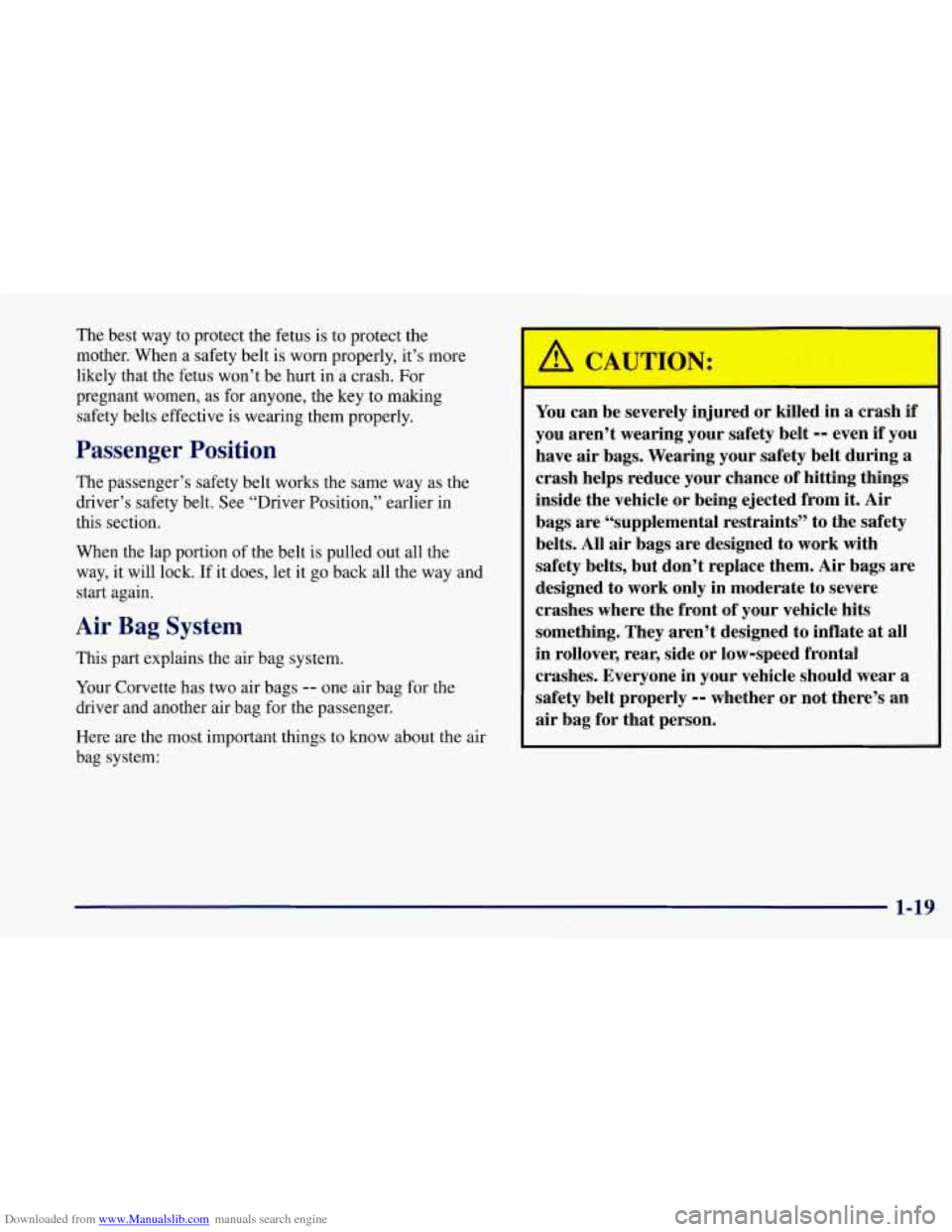Page 13 of 356
Downloaded from www.Manualslib.com manuals search engine Vehicle Symbols
These are some of the symbols you may find on your vehicle.
For example,
these symbols
are used on an
original battery:
POSSIBLE A
CAUTION
INJURY
PROTECT EYES BY
SHIELDING
CAUSTIC
ACID COULD BATTERY
CAUSE
BURNS
AVOID
SPARKS
OR
FLAMES
SPARK
OR ,\I/,
COULD FLAME
EXPLODE BATTERY
L
These symbols are important
for you and
your passengers
whenever your
vehicle is
driven:
n
UNLOCK w
FASTEN
SEAT
BELTS
These symbols
have to do with
your lamps:
SIGNALS e
TURN
RUNNING
* . 0
DAYTIME -0
LAMPS ***
FOG LAMPS $0
These symbols are on some
of
your controls:
WINDSHIELD
WIPER
WINDSHIELD DEFROSTER
WINDOW
DEFOGGER
VENTILATING FAN
These symbols
are used on
warning and
indicator lights:
COOLANT
TEMP
-
CHARGING I-1
BATTERY
SYSTEM
BRAKE
(0)
ENGINE OIL w,
PRESSURE
ANTI-LOCK
(a)
BRAKES
Here are some
other symbols you may see:
FUSE -%-
LIGHTER m
HORN )a(
SPEAKER
b
FUEL B
Page 15 of 356

Downloaded from www.Manualslib.com manuals search engine Seats and Seat Controls Power Seat
This part tells you about the seats -- how to adjust them,
and also about reclining seatbacks and seatback latches.
Manual Front Seat (Option)
(Passenger Only)
,_i :
Pull up on the lever in front of the seat to unlock it.
Slide
the seat to where you want it. Then release the
lever
and try to move the seat with your body to make
sure the seat is locked into place. The
switch for the power seats is located
on the side of
each seat, near the base.
Different parts of the power seat control move different
parts of your seat. If you move the whole control, the
whole seat will move. The back of the control will raise
or lower the back of the seat, and the front of the control
will raise or lower
the front of the seat.
Move the control to the front or to the back
to move the
seat forward or backward. Move the control up
to raise
the seat and down to lower it.
Your preferred seat position can be stored and recalled
if you
have the memory option. See “Memory”
in the Index.
Page 16 of 356
Downloaded from www.Manualslib.com manuals search engine Sport Seat (Option)
In addition to the power seat control, there are three
other switches that help you change the shape of your
seat. There are two lumbar supports
(A and B) for the
middle and lower back. There’s
also a side bolster
switch
(C) that adjusts the sides of the seat around you
to give you more lateral support.
For lumbar support, move each switch
(A and B)
forward to inflate or rearward to deflate.
Move the side bolster switch
(C) up for more side
support and down for less support.
Reclining Seatbacks
The lever for the reclining seat back is located on the
side of each seat, near the base.
To adjust the seatback, pull up on the lever and tilt the
seatback to where you want it. Release the lever to lock
the seatback into place.
1-3
Page 18 of 356
Downloaded from www.Manualslib.com manuals search engine Seatback Latches
I
Both seatbacks fold forward to give you access to the
rear area.
To fold a seatback forward, lift this latch and
pull the seatback forward. The seatback will lock down
in this position. To unlock, lift up on the latch and push
the seatback rearward. When you return the seatback to
its original position, make sure the seatback is locked.
If the seatback isn’t locked, it could move
forward in a sudden stop or crash. That could
cause injury to the person sitting there. Always
press rearward on the seatback to be sure it
is locked.
1-5
Page 25 of 356
Downloaded from www.Manualslib.com manuals search engine Driver Position
This part describes the driver’s restraint system.
Lap-Shoulder Belt
The driver has a lap-shoulder belt. Here’s how to
it properly.
1. Close and lock the door.
2. Adjust the seat (to see how, see “Seats’? in the
so you can sit up straight. wear
Index)
3. Pick up the latch plate and pull the belt across you.
Don’t let it get twisted.
When the lap portion
of the belt is pulled out all the
way, it will lock.
If it does, let it go back all the way
and start again. See “Lap Belt Cinch Feature” in
the Index.
I 1-12
Page 26 of 356

Downloaded from www.Manualslib.com manuals search engine 4. Push the latch plate into the buckle until it clicks.
Pull up on the latch plate to make sure it is secure. If
the belt isn’t long enough, see “Safety Belt
Extender” at the end of this section.
Make sure the release button on the buckle is
positioned
so you would be able to unbuckle the
safety belt quickly if you ever had to. The lap part
of the belt should be
worn low and snug on
the hips, just touching the thighs. In a crash, this applies
force to the strong pelvic bones. And you’d be less
likely to slide under the lap belt. If you slid under it, the
belt would apply force at your abdomen. This could
cause serious or even fatal injuries. The shoulder belt
should go over the shoulder and across the chest.
These parts of the body are best able to take belt
restraining forces.
The safety belt locks if there’s a sudden stop or crash.
Lap Belt Cinch Feature
If you do not want the lap belt to move freely, pull the
lap belt out all the way to set the lock. To permit the lap
belt to move freely again, unbuckle the belt, let it retract
all the way, and buckle up again.
1-13
Page 32 of 356

Downloaded from www.Manualslib.com manuals search engine The best way to protect the fetus is to protect the
mother. When a safety belt is worn properly, it’s more
likely that the fetus won’t be hurt in a crash. For
pregnant women, as for anyone, the key to making
safety belts effective
is wearing them properly.
Passenger Position
The passenger’s safety belt works the same way as the
driver’s safety belt. See “Driver Position,’’ earlier in
this section.
When the lap portion of the belt
is pulled out all the
way, it will lock. If it does, let it
go back all the way and
start again.
Air Bag System
This part explains the air bag system.
Your Corvette has two air bags
-- one air bag for the
driver and another air bag for the passenger.
Here are the most important things to know about the air
bag system:
L
You can be severely injured or killed in a crash if
you aren’t wearing your safety belt -- even if you
have
air bags. Wearing your safety belt during a
crash helps reduce your chance of hitting things
inside the vehicle or being ejected from it. Air
bags are “supplemental restraints” to the safety
belts. All air bags are designed to work with
safety belts, but don’t replace them. Air bags are
designed to work only in moderate to severe
crashes where the front of your vehicle hits
something. They aren’t designed to inflate at all
in rollover, rear, side or low-speed frontal
crashes. Everyone in your vehicle should wear a
safety belt properly
-- whether or not there’s an
air bag for that person.
1-19
Page 42 of 356
Downloaded from www.Manualslib.com manuals search engine A
5. Buckle the belt. Make sure the release button is
positioned
so you would be able to unbuckle the
safety belt quickly if you ever had to.
6. Pull the rest of the lap belt all the way out of the
retractor to set the lock.
1-29